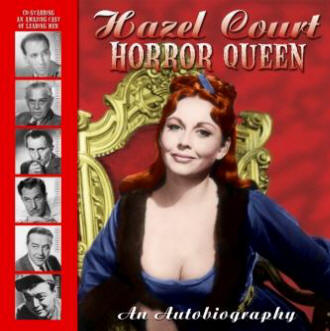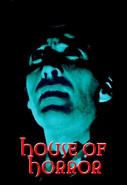|
 Reading
Hazel Court's autobiography its virtually impossible not
to be moved, particularly the closing paragraphs with
their tones of a woman who has lived a full and long
life. Closure seems to be implicit, and as we now know,
this look back did in fact end up being a eulogy. Hazel
Court died suddenly, having completed the manuscript for
the book, having not seen the proofs for the text. With
this knowledge one's view of the book is tainted... can
we fault someone's last words? Reading
Hazel Court's autobiography its virtually impossible not
to be moved, particularly the closing paragraphs with
their tones of a woman who has lived a full and long
life. Closure seems to be implicit, and as we now know,
this look back did in fact end up being a eulogy. Hazel
Court died suddenly, having completed the manuscript for
the book, having not seen the proofs for the text. With
this knowledge one's view of the book is tainted... can
we fault someone's last words?
Perhaps
surprisingly, the text wasn't amended to include mention
of Hazel's sudden departure. There will no doubt be
people out there who on reading the text are delighted
to learn that she was enjoying old age. A major launch
had been planned and she was set to do a tour of the UK
to promote the book, with the NFT prepared to put on a
special evening for her.
Despite
the title "Horror Queen", the book doesn't dwell on the
few horror films that readers of the book are no doubt
most familiar with. Similarly the assorted personalities
featured on the cover are in some cases receive nothing
more than a brief mention (Peter Lorre, Boris Karloff,
Ray Milland). Frustratingly one imagines that Hazel
could have said much much more about those experiences -
and perhaps interviews on the book tour would have
brought that up.
As it is
we are left with a very personal reflection of an
exciting life which encompasses acting and art, an early
life in the UK and a migration to the United States,
where she would spend her last days. Of her daughter,
and two marriages. She speaks with a surprising
affection for first husband Dermot Walsh, and with love
and loss for second husband Don Taylor. The prose is
informal, engaging and easy - the glimpses into worlds
past all too brief.
I enjoyed
every page of Horror Queen, and it was Hazel's right to
tell her story this way. Perhaps I would have liked more
reflection on her films - the sort of detail that
perhaps Little Shoppe of Horrors would tease out in an
interview - more about the people she worked with. She
seems to hold back from details, and hints at more
salacious stories, of deeper emotions which the book
might have benefited from. There's a few factual errors
about films which should have been picked up by a
knowledgeable proof-reader, but that would be a minor
quibble and inevitable in any text based on memory.
Perhaps
more than that I was most disappointed not to learn more
about her life and work as an artist. There are only a
couple of reproductions in the text of her artwork and
it does little to enhance our understanding of this
important side of her life - and yet some of the stories
she tells about studying in Italy are delightful, and
earn a new respect (much as when first learning about
Vincent Price's leanings towards the other arts enriched
my appreciation of him).
The book
is lavishly illustrated with many black and white
photographs, with a few colour images for measure.
Nearly all are perfectly reproduced and rich in detail.
There's more glamour shots than I ever expected, and
Hammer fans will no doubt be delighted to see one of the
infamous frames of her nude appearance from The Man
Who Could Cheat Death (in much more detail than the
Little Shoppe of Horrors repro from a few years
ago).
Horror
fans may be a little disappointed, but Hazel's fans, and
anyone with an interest in the film industry in the
1950s should find the book stimulating. Its refreshing
to read an account with such levels of enthusiasm and
warmth, and with little of the exploitation and
back-biting that many memoirs feel obliged to include.
As a tribute to a great, under-appreciated actress, I
can't think of anything more fitting. We can only thank
Hazel for sharing her life with us.
© RJE Simpson 2008
review posted 04.07.2008 |


 -
-
 Reading
Hazel Court's autobiography its virtually impossible not
to be moved, particularly the closing paragraphs with
their tones of a woman who has lived a full and long
life. Closure seems to be implicit, and as we now know,
this look back did in fact end up being a eulogy. Hazel
Court died suddenly, having completed the manuscript for
the book, having not seen the proofs for the text. With
this knowledge one's view of the book is tainted... can
we fault someone's last words?
Reading
Hazel Court's autobiography its virtually impossible not
to be moved, particularly the closing paragraphs with
their tones of a woman who has lived a full and long
life. Closure seems to be implicit, and as we now know,
this look back did in fact end up being a eulogy. Hazel
Court died suddenly, having completed the manuscript for
the book, having not seen the proofs for the text. With
this knowledge one's view of the book is tainted... can
we fault someone's last words?